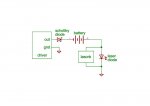There is a simple solution for this problem... if you put a battery at the output of the driver and in series with the load, you solve the problem because the driver output voltage adds itself to the battery voltage (you must connect the negative of the battery to the driver output and the positive to the diode).
If you simulate this situation with tina-ti you will find that you can drive a test-load of 12 silicon diodes.
You will have a two-batteries buck-boost driver with extended output range and also with relaxed driver operation.
This solution could be, more generally, applicable to any driver and a battery that can sustain the output current flow through itself





